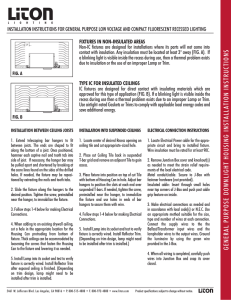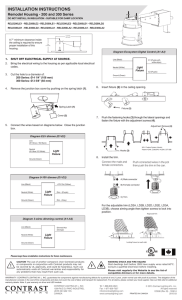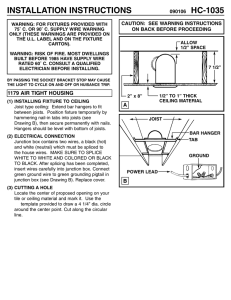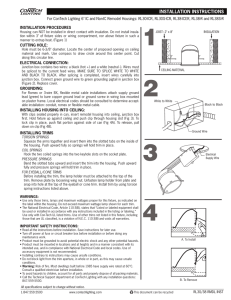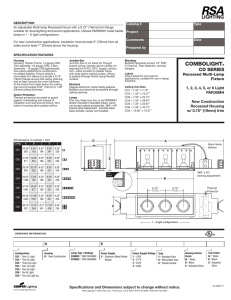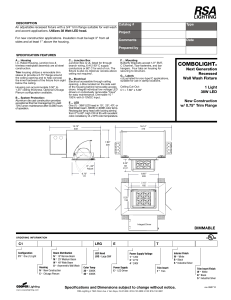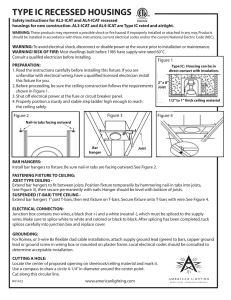Install English - Sea Gull Lighting
advertisement
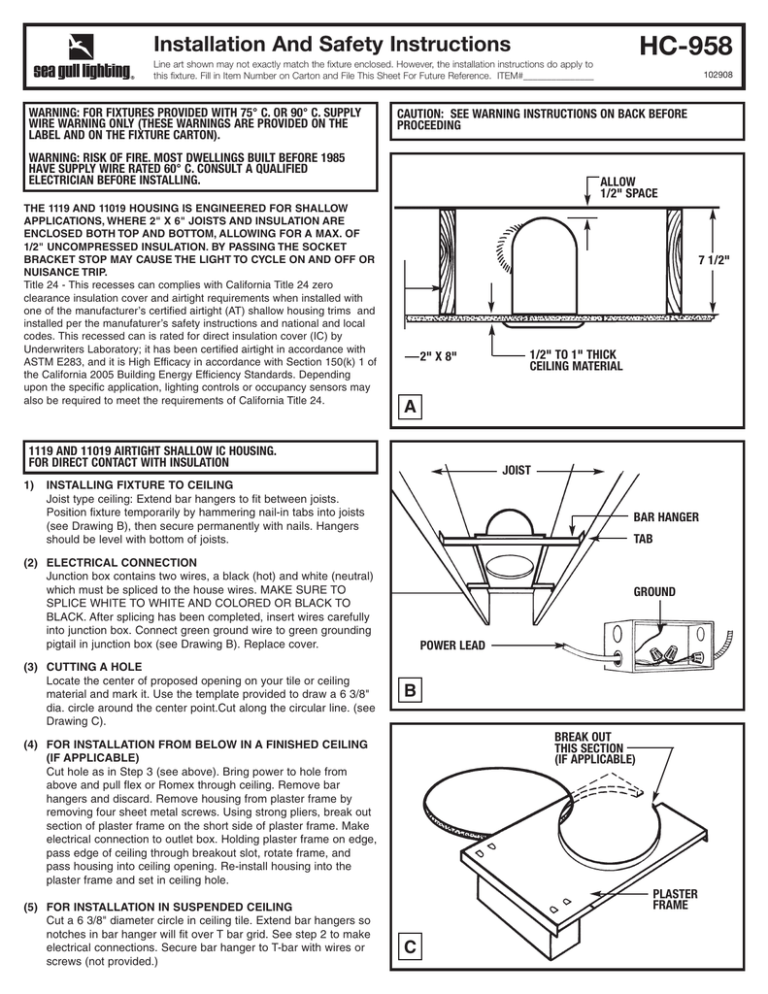
HC-958 Installation And Safety Instructions Line art shown may not exactly match the fixture enclosed. However, the installation instructions do apply to this fixture. Fill in Item Number on Carton and File This Sheet For Future Reference. ITEM#_______________ WARNING: FOR FIXTURES PROVIDED WITH 75° C. OR 90° C. SUPPLY WIRE WARNING ONLY (THESE WARNINGS ARE PROVIDED ON THE LABEL AND ON THE FIXTURE CARTON). CAUTION: SEE WARNING INSTRUCTIONS ON BACK BEFORE PROCEEDING WARNING: RISK OF FIRE. MOST DWELLINGS BUILT BEFORE 1985 HAVE SUPPLY WIRE RATED 60° C. CONSULT A QUALIFIED ELECTRICIAN BEFORE INSTALLING. THE 1119 AND 11019 HOUSING IS ENGINEERED FOR SHALLOW APPLICATIONS, WHERE 2" X 6" JOISTS AND INSULATION ARE ENCLOSED BOTH TOP AND BOTTOM, ALLOWING FOR A MAX. OF 1/2" UNCOMPRESSED INSULATION. BY PASSING THE SOCKET BRACKET STOP MAY CAUSE THE LIGHT TO CYCLE ON AND OFF OR NUISANCE TRIP. Title 24 - This recesses can complies with California Title 24 zero clearance insulation cover and airtight requirements when installed with one of the manufacturer’s certified airtight (AT) shallow housing trims and installed per the manufaturer’s safety instructions and national and local codes. This recessed can is rated for direct insulation cover (IC) by Underwriters Laboratory; it has been certified airtight in accordance with ASTM E283, and it is High Efficacy in accordance with Section 150(k) 1 of the California 2005 Building Energy Efficiency Standards. Depending upon the specific application, lighting controls or occupancy sensors may also be required to meet the requirements of California Title 24. ALLOW 1/2" SPACE 7 1/2" 2" X 8" JOIST INSTALLING FIXTURE TO CEILING Joist type ceiling: Extend bar hangers to fit between joists. Position fixture temporarily by hammering nail-in tabs into joists (see Drawing B), then secure permanently with nails. Hangers should be level with bottom of joists. BAR HANGER TAB (2) ELECTRICAL CONNECTION Junction box contains two wires, a black (hot) and white (neutral) which must be spliced to the house wires. MAKE SURE TO SPLICE WHITE TO WHITE AND COLORED OR BLACK TO BLACK. After splicing has been completed, insert wires carefully into junction box. Connect green ground wire to green grounding pigtail in junction box (see Drawing B). Replace cover. (3) CUTTING A HOLE Locate the center of proposed opening on your tile or ceiling material and mark it. Use the template provided to draw a 6 3/8" dia. circle around the center point.Cut along the circular line. (see Drawing C). GROUND POWER LEAD B BREAK OUT THIS SECTION (IF APPLICABLE) (4) FOR INSTALLATION FROM BELOW IN A FINISHED CEILING (IF APPLICABLE) Cut hole as in Step 3 (see above). Bring power to hole from above and pull flex or Romex through ceiling. Remove bar hangers and discard. Remove housing from plaster frame by removing four sheet metal screws. Using strong pliers, break out section of plaster frame on the short side of plaster frame. Make electrical connection to outlet box. Holding plaster frame on edge, pass edge of ceiling through breakout slot, rotate frame, and pass housing into ceiling opening. Re-install housing into the plaster frame and set in ceiling hole. (5) FOR INSTALLATION IN SUSPENDED CEILING Cut a 6 3/8" diameter circle in ceiling tile. Extend bar hangers so notches in bar hanger will fit over T bar grid. See step 2 to make electrical connections. Secure bar hanger to T-bar with wires or screws (not provided.) 1/2" TO 1" THICK CEILING MATERIAL A 1119 AND 11019 AIRTIGHT SHALLOW IC HOUSING. FOR DIRECT CONTACT WITH INSULATION 1) 102908 PLASTER FRAME C INSTALLATION (continued) HC-958 INSTALL TRIM ASSEMBLIES Install trim by one of the following methods: TORSION SPRINGS TORSION SPRINGS: Squeeze the arms together and insert them into the slotted tabs on the inside of the housing. Push upward fully so springs will hold trim in place (see Diagram 1). COIL SPRINGS: You must bend the slotted tabs back up out of the way (just push upward with finger). Then hook the coil springs into the slots cut into the sides of the housing (see Diagram 2). SLOTTED TABS PRESSURE SPRINGS: Bend slotted tabs up and insert trim into housing. Push upward fully and pressure springs will hold trim in place (see Diagram 3). TO INSTALL LAMPS: Select proper lamp (see lamp maximum wattage label in housing). Do not exceed maximum wattage lamp shown for each trim. FOR EYEBALL TRIMS: Before installing trim, remove socket plate from housing by loosening wing nut. Unfasten socket from socket plate and snap into hole provided in top of trim. TORSION SPRINGS TRIM 1 COIL SPRINGS HOUSING SOCKET PLATE COIL SPRING CAUTION! THE FOLLOWING RULES MUST BE ADHERED TO WHEN INSTALLING LIGHT FIXTURES. FAILURE TO COMPLY WITH THESE REQUIREMENTS COULD LEAD TO AN ELECTRICAL SHOCK OR FIRE WHICH COULD BE INJURIOUS OR EVEN FATAL. TRIM 2 MAKE CERTAIN: 1) TO DISCONNECT POWER AT MAIN FUSE BOX BEFORE INSTALLING FIXTURE. 2) THE GROUND WIRE (BARE OR GREEN INSULATED WIRE) IS NOT CONNECTED TO CURRENT CARRYING SUPPLY WIRES. 3) NO BARE WIRES ARE EXPOSED OUTSIDE OF CONNECTORS WHEN CONNECTING CURRENT CARRYING FIXTURE WIRES TO CURRENT CARRYING HOUSE WIRES. 4) THE INSULATION ON FIXTURE WIRES HAS NOT BEEN DAMAGED DURING INSTALLATION. 5) NO ROUGH OR SHARP EDGES OF ANY SURFACE ARE IN CONTACT WITH WIRES. 6) FIXTURE SUPPLY WIRES ARE CONNECTED TO PROPER HOUSE SUPPLY WIRES. 7) TO USE LIGHT BULBS WITH WATTAGES NO GREATER THAN SPECIFIED FOR THE FIXTURE. PRESSURE SPRINGS BEND UP PRESSURE SPRINGS TRIM 3 IF YOU HAVE ANY DOUBTS ABOUT HOW TO INSTALL A LIGHT FIXTURE OR IT FAILS TO OPERATE PROPERLY, CONTACT A LOCAL LICENSED ELECTRICIAN.

